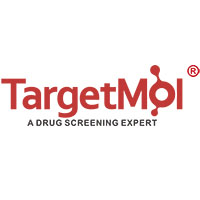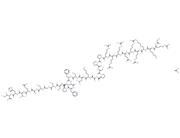| Name | Tat-beclin 1 acetate |
| Description | Tat-beclin 1 acetate is a potent inducer of autophagy and interacts with the negative regulator of autophagy, GAPR-1. Tat-beclin 1 acetate decreases the accumulation of polyglutamine expansion protein aggregates and the replication of several pathogens (including HIV-1). |
| In vitro | Tat-beclin 1 acetate (10 μM; 2-4 hours post-infection) decreases the intracellular survival of L. monocytogenes in primary murine bone-marrow-derived macrophages (BMDMs)[1]. Tat-beclin 1 acetate (10, 30, 50 μM; 24 hours) induces autophagy and results in a dose-dependent decrease in amounts of p62, a selective autophagy substrate, and a dose-dependent conversion of the non-lipidated form of LC3, LC3-I, to the lipidated, autophagosome-associated form of LC3, LC3-II, in multiple cell lines and primary murine embryonic fibroblasts (MEFs)[1]. |
| In vivo | Tat-beclin 1 acetate reduces mortality in mice infected with chikungunya (CHIKV) or West Nile virus (WNV). Tat-beclin 1 acetate (15 mg/kg; i.p.) induces autophagy in peripheral tissues in adult mice as well as in the central nervous system of neonatal mice[1]. |
| Storage | keep away from moisture | Powder: -20°C for 3 years | In solvent: -80°C for 1 year | Shipping with blue ice/Shipping at ambient temperature. |
| Solubility Information | DMSO : 45 mg/mL, Sonication is recommended.
|
| Keywords | Tat-beclin 1 Acetate | Tatbeclin 1 acetate | Tat beclin 1 acetate | HIVProtease | HIV-1 | HIV Protease | Autophagy |
| Inhibitors Related | Stavudine | Aceglutamide | Emtricitabine | Cysteamine hydrochloride | Sodium 4-phenylbutyrate | Hydroxychloroquine | Lamivudine | Guanidine hydrochloride | Paeonol | Naringin | Alginic acid | Gefitinib |
| Related Compound Libraries | Peptide Compound Library |

 United States
United States






